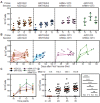Tracking B Cell Memory to SARS-CoV-2 Using Rare Cell Analysis System
- PMID: 37112647
- PMCID: PMC10145117
- DOI: 10.3390/vaccines11040735
Tracking B Cell Memory to SARS-CoV-2 Using Rare Cell Analysis System
Abstract
Rapid mutations within SARS-CoV-2 are driving immune escape, highlighting the need for in-depth and routine analysis of memory B cells (MBCs) to complement the important but limited information from neutralizing antibody (nAb) studies. In this study, we collected plasma samples and peripheral blood mononuclear cells (PBMCs) from 35 subjects and studied the nAb titers and the number of antigen-specific memory B cells at designated time points before and after vaccination. We developed an assay to use the MiSelect R II System with a single-use microfluidic chip to directly detect the number of spike-receptor-binding domain (RBD)-specific MBCs in PBMCs. Our results show that the number of spike-RBD-specific MBCs detected by the MiSelect R II System is highly correlated with the level of nAbs secreted by stimulated PBMCs, even 6 months after vaccination when nAbs were generally not present in plasma. We also found antigen-specific cells recognizing Omicron spike-RBD were present in PBMCs from booster vaccination of subjects, but with a high variability in the number of B cells. The MiSelect R II System provided a direct, automated, and quantitative method to isolate and analyze subsets of rare cells for tracking cellular immunity in the context of a rapidly mutating virus.
Keywords: SARS-CoV-2; memory B cells; rare cells; vaccines.
Conflict of interest statement
The authors receive financial benefit from MiCareo via employment, ownership, or intellectual property. Nathan Chen may additionally receive financial benefit from Adimmune Corporation via employment, ownership, or intellectual property.
Figures






Similar articles
-
Cellular and Humoral Responses to Recombinant and Inactivated SARS-CoV-2 Vaccines in CKD Patients: An Observational Study.J Clin Med. 2023 Feb 3;12(3):1225. doi: 10.3390/jcm12031225. J Clin Med. 2023. PMID: 36769873 Free PMC article.
-
Comprehensive mapping of binding hot spots of SARS-CoV-2 RBD-specific neutralizing antibodies for tracking immune escape variants.Genome Med. 2021 Oct 14;13(1):164. doi: 10.1186/s13073-021-00985-w. Genome Med. 2021. PMID: 34649620 Free PMC article.
-
Antibody Avidity and Neutralizing Response against SARS-CoV-2 Omicron Variant after Infection or Vaccination.J Immunol Res. 2022 Aug 31;2022:4813199. doi: 10.1155/2022/4813199. eCollection 2022. J Immunol Res. 2022. PMID: 36093434 Free PMC article.
-
Safety and immunogenicity of inactivated COVID-19 vaccine in patients with metabolic syndrome: A cross-sectional observational study.Front Public Health. 2022 Dec 23;10:1067342. doi: 10.3389/fpubh.2022.1067342. eCollection 2022. Front Public Health. 2022. PMID: 36620297 Free PMC article.
-
SARS-CoV-2 Omicron-neutralizing memory B cells are elicited by two doses of BNT162b2 mRNA vaccine.Sci Immunol. 2022 Apr 22;7(70):eabn8590. doi: 10.1126/sciimmunol.abn8590. Epub 2022 Apr 22. Sci Immunol. 2022. PMID: 35113654 Free PMC article.
References
-
- Joseph M., Wu Y., Dannebaum R., Rubelt F., Zlatareva I., Lorenc A., Du Z.G., Davies D., Kyle-Cezar F., Das A., et al. Global patterns of antigen receptor repertoire disruption across adaptive immune compartments in COVID-19. Proc. Natl. Acad. Sci. USA. 2022;119:e2201541119. doi: 10.1073/pnas.2201541119. - DOI - PMC - PubMed
-
- Saggau C., Martini G.R., Rosati E., Meise S., Messner B., Kamps A.-K., Bekel N., Gigla J., Rose R., Voß M., et al. The pre-exposure SARS-CoV-2-specific T cell repertoire determines the quality of the immune response to vaccination. Immunity. 2022;55:1924–1939.e5. doi: 10.1016/j.immuni.2022.08.003. - DOI - PMC - PubMed
LinkOut - more resources
Full Text Sources
Miscellaneous

